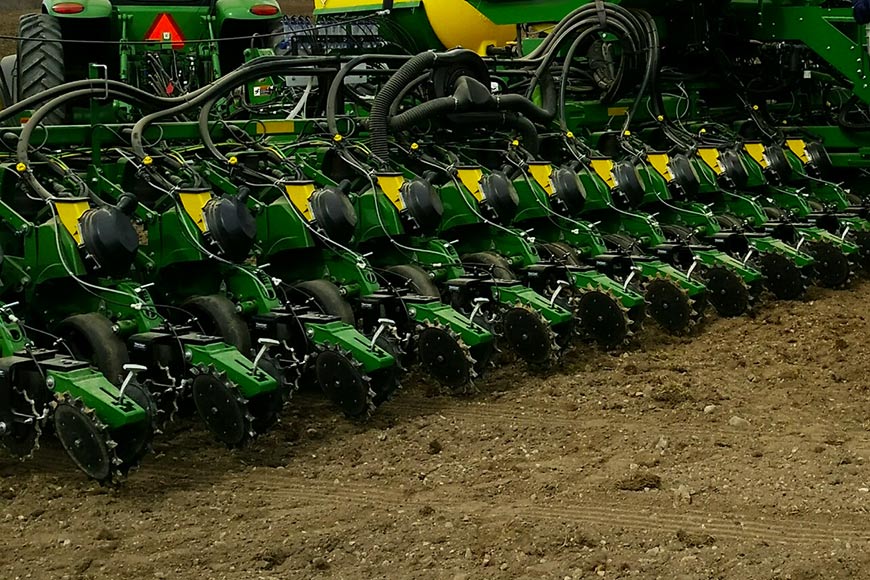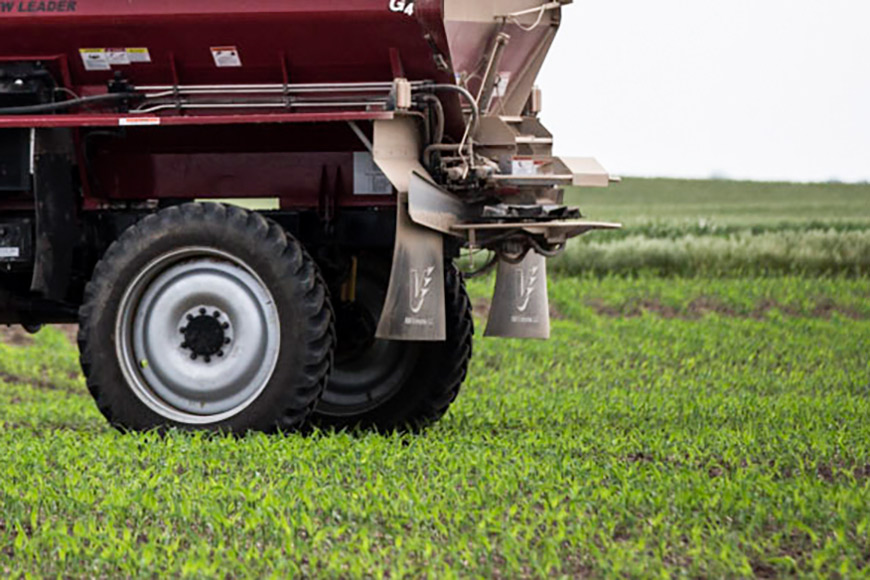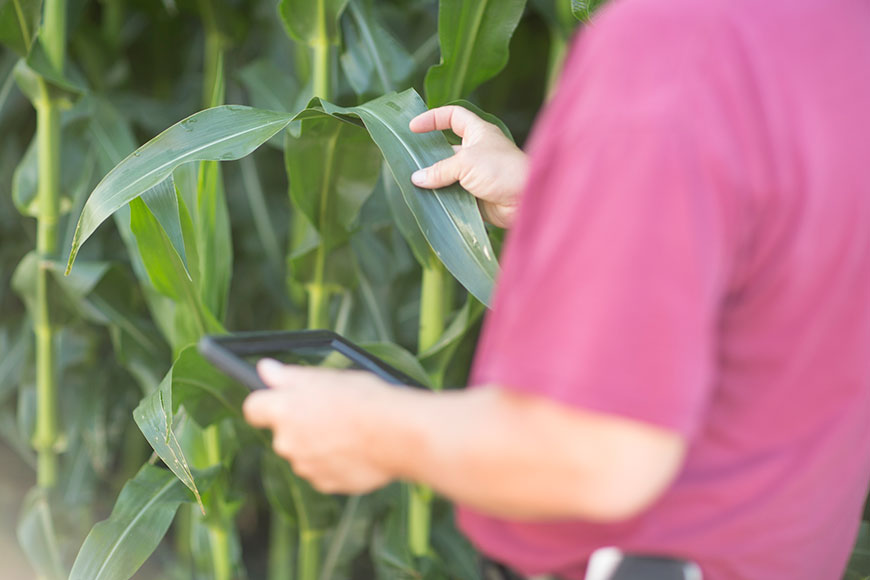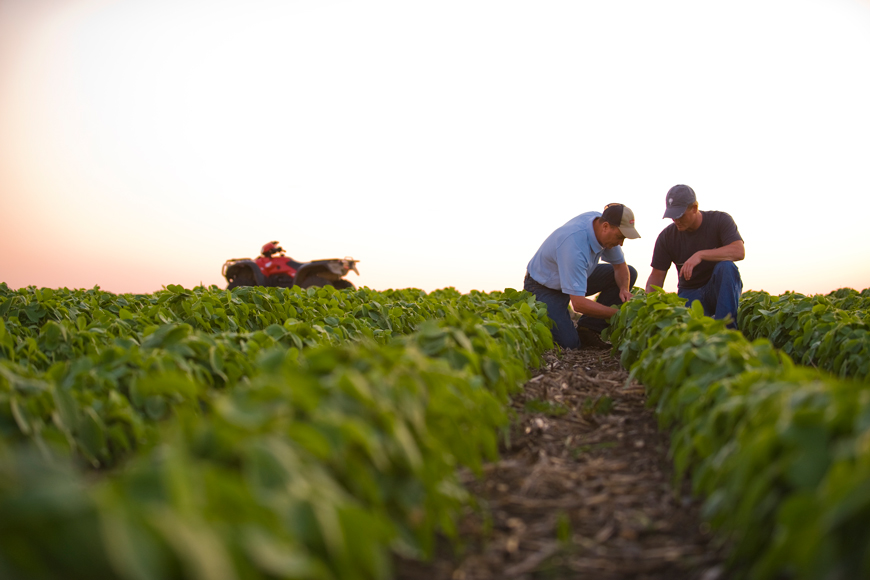Patience, Flexibility Pay Off in Strip-Till

Have you considered devoting a certain number of your acres to strip-till farming? I work with a farmer named Leigh Barry, who has an operation near Fergus Falls in west-central Minnesota and started using strip-till four years ago. He now employs the method on about a third of his corn acres.
There is a standing joke between Leigh, his farming partners and me that the farm plan never gets laminated. We have plan A, plan B, plan C and so forth. Patience and the flexibility to make adjustments on the fly are necessary to be successful when incorporating strip-till into your farm operation. Even though it may take some extra effort and planning, it has proven to be a practice that can positively affect farmers’ ROI potential, with less fertilizer and water needed and more yield potential achieved.
Strip-till, briefly
The aim of strip-till farming is to use a minimum amount of tillage, which supports soil sustainability and combats erosion by disturbing only the portion of the soil that the seed row will be placed. This practice keeps the natural soil microbial activity at peak performance, among many other benefits that support the soil’s health. It also provides a way to make nutrient applications more precise. A concentrated band of fertilizer is placed below the soil (usually in the fall, but sometimes in the spring) with seed placed above that band. This optimizes uptake by placing nutrients where they can be best used by the plant — under its root cluster.
Leigh began by leasing a strip-till machine in the first year to test how it would work on his acres, some of which, he notes, “aren’t exactly Iowa flat.” But even though his land contains some rolling hills and other challenging terrain, he loves the conservation aspect of it for that same reason and has also found the precise nutrient placement results in savings that make the investment worth it.
“There’s definitely been a learning curve,” he says. “But the efficiency of placing fertilizer in the zone where the plant has easy access instead of broadcasting and working it in has resulted in less soil disturbance and better fertilizer efficiency for the plant. We’ve been able to increase yield with less fertilizer and build better soil health, specifically organic matter.”
Benefits and challenges
Leigh and his farming partners are relentless when it comes to making something work and giving it their best shot to be successful. Leigh knew that his soil types were good candidates for a less aggressive tillage system, but he also didn’t want to sacrifice yield or optimal nutrient placement below the soil, which made strip-till a great solution.
Strip-till benefits can include:
Strip-till challenges can include:
Flexibility is important
Leigh doesn’t strip-till on some of his rolling ground with steep slopes because of the difficulty in getting adequate horsepower to maneuver the machinery correctly. “We only strip-till where we know we can get exactly on the strip,” he says. “And even that gets changed up. We need to be able to prepare the proper seedbed to get our stand off to the best start possible.”
“We always have a farm plan, but some years when we planned on strip-tilling, we got a late snowfall or had a cold spring that pushed our planting window back, and we knew we needed to get seed in the ground quickly,” he notes. “So, we needed to scratch a couple of fields off the strip-till list and go back to conventional tillage just for that season because the weather didn’t allow it.” Leigh and his farming partners were going to strip-till on some of their heavier soils last fall since they had success with that before, but things froze up early and they will conventionally till that land this year.
“You can’t buy a strip-till machine and think, ‘I’m going to strip-till every acre, every year,’” he says. “That’s not reality, at least not for us.”
Are you a candidate for strip-till?
In addition to Leigh, I work with four other farmers who employ some degree of strip-tillage on their operations. Generally speaking, farmers who have lighter soil types are better candidates, since these soil types are better served with minimal tillage. Strip-till may not work on farms with very steep slopes or without the technology needed to place the seed row exactly over the strip. In either situation, seed rows may not get planted exactly on the strip, and on steep slopes the strips may be “blown out” with wind or water erosion on the most highly erodible land.
Have you thought about using strip-till on some of your acres? Talk with your agronomist to see if strip-till makes sense to try on your operation. If you’re interested in advancing sustainability, promoting better soil health and being more efficient with fertility and moisture on your farm, there is a lot to be said for this method. There are also programs offered through the Natural Resources Conservation Service (NRCS) to fund such practices on farming operations that can be discussed with your county agent or a WinField United-aligned agronomist.
“Using strip-till has been a learning experience for us, and things continue to work better each season,” says Leigh. “It’s not for everybody. You have to dedicate yourself to it and be a little bit patient to take advantage of it. Not being afraid to tweak our management practices and management over the years has brought real value to our operation.”
There is a standing joke between Leigh, his farming partners and me that the farm plan never gets laminated. We have plan A, plan B, plan C and so forth. Patience and the flexibility to make adjustments on the fly are necessary to be successful when incorporating strip-till into your farm operation. Even though it may take some extra effort and planning, it has proven to be a practice that can positively affect farmers’ ROI potential, with less fertilizer and water needed and more yield potential achieved.
Strip-till, briefly
The aim of strip-till farming is to use a minimum amount of tillage, which supports soil sustainability and combats erosion by disturbing only the portion of the soil that the seed row will be placed. This practice keeps the natural soil microbial activity at peak performance, among many other benefits that support the soil’s health. It also provides a way to make nutrient applications more precise. A concentrated band of fertilizer is placed below the soil (usually in the fall, but sometimes in the spring) with seed placed above that band. This optimizes uptake by placing nutrients where they can be best used by the plant — under its root cluster.
Leigh began by leasing a strip-till machine in the first year to test how it would work on his acres, some of which, he notes, “aren’t exactly Iowa flat.” But even though his land contains some rolling hills and other challenging terrain, he loves the conservation aspect of it for that same reason and has also found the precise nutrient placement results in savings that make the investment worth it.
“There’s definitely been a learning curve,” he says. “But the efficiency of placing fertilizer in the zone where the plant has easy access instead of broadcasting and working it in has resulted in less soil disturbance and better fertilizer efficiency for the plant. We’ve been able to increase yield with less fertilizer and build better soil health, specifically organic matter.”
Benefits and challenges
Leigh and his farming partners are relentless when it comes to making something work and giving it their best shot to be successful. Leigh knew that his soil types were good candidates for a less aggressive tillage system, but he also didn’t want to sacrifice yield or optimal nutrient placement below the soil, which made strip-till a great solution.
Strip-till benefits can include:
- Decreased cost of production due to the lower rates of fertility needed to achieve the same or higher yields than with conventional tillage. (Leigh says he uses about 30 percent less fertilizer with strip-till than with a broadcast application.)
- Better water-holding capacity with increased organic matter, which results in less runoff and less irrigation needed on strip-till acres.
- The potential for earlier spring planting. Since tillage and fertility are done in the fall, fields are ready for planting as soon as soil conditions are warm enough.
Strip-till challenges can include:
- Getting a window of the right fall weather conditions to strip-till acres planned before complete freeze up.
- More difficult weed control, especially the management of winter annuals. (Leigh uses cover crops to help create a barrier that prevents weeds from emerging or taking over, along with burndown and residual weed control products.)
- Needing to monitor strip-till applications more than other tillage applications to make sure depth is consistent. Attention needs to be paid to the planter to make sure placement of the seed is correct so there are no air pocket issues or depth is not too shallow, since soil will compress in that band.
Flexibility is important
Leigh doesn’t strip-till on some of his rolling ground with steep slopes because of the difficulty in getting adequate horsepower to maneuver the machinery correctly. “We only strip-till where we know we can get exactly on the strip,” he says. “And even that gets changed up. We need to be able to prepare the proper seedbed to get our stand off to the best start possible.”
“We always have a farm plan, but some years when we planned on strip-tilling, we got a late snowfall or had a cold spring that pushed our planting window back, and we knew we needed to get seed in the ground quickly,” he notes. “So, we needed to scratch a couple of fields off the strip-till list and go back to conventional tillage just for that season because the weather didn’t allow it.” Leigh and his farming partners were going to strip-till on some of their heavier soils last fall since they had success with that before, but things froze up early and they will conventionally till that land this year.
“You can’t buy a strip-till machine and think, ‘I’m going to strip-till every acre, every year,’” he says. “That’s not reality, at least not for us.”
Are you a candidate for strip-till?
In addition to Leigh, I work with four other farmers who employ some degree of strip-tillage on their operations. Generally speaking, farmers who have lighter soil types are better candidates, since these soil types are better served with minimal tillage. Strip-till may not work on farms with very steep slopes or without the technology needed to place the seed row exactly over the strip. In either situation, seed rows may not get planted exactly on the strip, and on steep slopes the strips may be “blown out” with wind or water erosion on the most highly erodible land.
Have you thought about using strip-till on some of your acres? Talk with your agronomist to see if strip-till makes sense to try on your operation. If you’re interested in advancing sustainability, promoting better soil health and being more efficient with fertility and moisture on your farm, there is a lot to be said for this method. There are also programs offered through the Natural Resources Conservation Service (NRCS) to fund such practices on farming operations that can be discussed with your county agent or a WinField United-aligned agronomist.
“Using strip-till has been a learning experience for us, and things continue to work better each season,” says Leigh. “It’s not for everybody. You have to dedicate yourself to it and be a little bit patient to take advantage of it. Not being afraid to tweak our management practices and management over the years has brought real value to our operation.”




